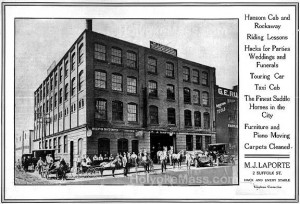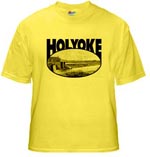by Laurel | October 8th, 2014
24 August 1902
Rush to Heated Flats Begins.
That excellent literary annual, the Holyoke City Directory, says in its summary of changes during the year past that there were 4689 changes of address made in compiling the book. This is in addition to the names erased and names added probably. Subtracting from the total changes of address those who have gone to jail or other places, the misses who have become madams, and those who could with felicity be placed in the lost, strayed or stolen column, the estimate of men in the business that 2500 or possibly 3000 families have “moved” during the year cannot be very wide of the mark. Even now in these beautiful days of a reversed almanac which gives us September and October weather in the dog days, the moving “bug” is getting in its deadly work, and great furniture vans are being hired to transport Smith or Jones from the “Heavenly Twins” apartment house to the “Cascaria” flats. Moving gives some families a prominence that they did not before possess, and a notice in Holyoke papers. Besides the husband of the family then has a chance to find 50 or 100 articles that the loving wife has put away so carefully that their existence is a myth. In a way moving has so much interest and excitement as is promised by the coming Holyoke fair.
Most of the moving in Holyoke is done by wither Mederic J. Laporte or Leon Laporte, both experts and friendly rivals in the business. It is intereting to note that the soaring in the price of coal has already started a rush for steam heated flats. The moving season is beginning early this summer. Generally it is along in September when the rush begins, but several jobs are being done every day now, and the number of inquiries both of flat owners and of the firms engaged in moving indicate an early and a rushing season. The philosophy of moving is closely connected with the philosophy of building. It’s like a row of bricks standing on end — push on end and the whole line falls down, one after another. A new block goes up an tenants move from some comparatively new block to this newest one. To the vacated block come others from less new ones — and so on until the very last, oldest and least improved block is deserted. Then the owner begins to wake up. He swears a little, consults an architect, a plumber, a painter and a paperer, and presently, lo, his block is transformed even like unto a new block and tenants flock to him again.
The process of moving is a deep and intricate one and those who have a few minutes to study mankind find it profitable to gaze reverently at the spectacle. Generally the team will arrive at the house two hours behind time. There have been cases when the team has been only an hour late, it is claimed, but no one has been found to vouch for it. Soon after arrival the men discover that something is missing, and men and team disappear while the prospective movers sit around on boxes and barrels and plan the destruction of the missing men. But when they do get to work they proceed with all deftness. All the old jokes about things being broken by wholesale by the moving fraternity are on the shelf. The up-to-date Holyoke mover seldom breaks anything; quite often moving is accomplished with hardly a scratch. It’s the man who has to pay the bill that is “broke.” Meantime all the neighbors gather around at safe distances or peer through window curtains and take a careful inventory of the personal property of the family moving which will furnish food for conversation and comparison for a number of moons. The work of loading and unloading as well are done generally with good speed.
There are all sorts of prices for moving. The wise man makes his bargain in advance, which can generally be arranged pretty closely, depending upon the distance, number of loafs, floor, if in a block, etc. One of the highest-priced “jobs” (all moving is classified as “jobs’) was a well known Holyoker to this city, whose bill was $105. Jobs costing $50 are not rare and occasionally there are jobs costing $70 or $75. But those of three figures are rare. An average moving costs anywhere from $8 to $25. Probably more are moved at from $10 to $15 than any others. There are many of the humbler classes moved by express men at a cost of $2 to $5, but they are not considered by the king pins in the business. Some jobs are taken as low as $4 or $5, but not many. There is always two currents of moving that the firms can depend upon as a pretty regular source of income. One is the city dweller who wants to move into the suburbs, and the other is the suburbanite who has got tired of life “out” and wants to come back to the city. So from year to year these two streams flow,keeping the property owners in the city and out in good humor and making business good for the firms engaged in moving.
“Twenty-seven years ago I started in business with one old horse, a decrepit shack of a wagon and $55 in debt,” said M. J. Laporte one evening last week. “M.J.,” as his friends often call him, was in reminiscent mood, and lighting his cigar afresh recounted his early struggles. “I was employed, then a lad of 17, at $9 a week with a firm that suddenly went out of business. They wanted to sell me their horse and wagon. The horse was a discouraged veteran, and the wagon was built apparently out of the remnants of an old junk shop. They wanted $60 for the outfit, and I borrowed $55 of my brother and put in $5 of my own, and took it and immediately started in the express business. Well, sir, those first few years make me ache even now to remember. But I made up my mind that I would succeed and nothing should stop me. To begin with, there was a strong rivalry in the business. One man named Smith was particularly active. If he had an idea that I had a “job” he would send off one of his men to the place and instruct him to say that I was unable to come, and meantime he would detain me in conversation and thus try to run the job off from my hands. Finally I caught on to his game, and I had a short talk with him that ended his activity of this sort.
“But there was enough left to discourage me. The wagon was not strong, and if I attempted to carry anything like a load something would break, the harness or the wagon, and delay me, besides costing me money. I had to take smaller loafs, and the jeers and gibes of my competitors were hard to bear. Two things were in my favor — I did not drink and I was always on hand from 5 in the morning until late at night. I had hardly got the outfit paid for when my horse gave out and died on my hands. Next I bought a gray horse that lacked bottom and lasted but a few months, and I was deeper in debt than ever. I traded for another horse, that died in only a few hours of colic. I had a veterinary work over it hald a day, and at the end of the time he told me the best thing that I could do would be to lead it to a place where I could bury it, and thus save cartage. It was with a sad heart that I tugged at the halter of the horse leading it to the dingle above the present high school, and, sure enough the horse died within a few minutes of reaching the spot.”
“Every day I had worked hard, scarcely allowing myself time to eat and sleep, and my luck seemed to be all against me. I was almost ready at times to give up, but I gritted my teeth and resolved to make another trial. I went out to Fuller’s at Indian Orchard, and bought myself a young horse for $165, agreeing to pay a certain sum down and so much a month. The horse was a nice animal, but not strong enough for my work, for in three months it was so badly knee-sprung as to be almost useless. I took it back to Fuller, and he looked it over, and said that he could do nothing for me. That was the most discouraged hour I ever knew. I was about ready to give up. I did not know which way to turn, and was about going away when he said, “Stop a minute, I have an old animal on a cart that might do.” Presently I both heard it and saw it. It was an old horse — 17 years old, and it puffed like a steam engine. I took it and agreed to pay $40 more, I think. But the horse was tough. You couldn’t kill it, and though I worked it so hard at times that it would be down in the shafts in broad daylight on the Dwight Street square, it stayed by me. It seemed to be a sort of mascot, for soon, after things began to come my way, I had won a good name by attending to business, and keeping my agreements perhaps; at any rate, I soon took a subcontract of Peter Martin, the lamplighter. For $35 a month I agreed to light all of the lamps in Wards 1, 2 and 3 — Ward 3 did not include Elmwood in those days — and turn out all of the gas lamps at 11. There were no lights after 11 in this time of the city’s history. About 5 or 6 I would take my naphtha can and make the tour of the 150 naphtha or kerosene lights, fill the lamps and light them, and at 11 at night I would turn out the 150 or 200 lamps, getting into bed from 12:15 to 12:30, and all the time getting up and a work at 5 in the morning. Soon I happened to get the lamplighting contract for the city for a ear, my moving business helped me develop a carpet-cleaning industry; I was able to buy more horses and teams, and the uphill pull was over.”
Adapted from The Springfield Republican.









